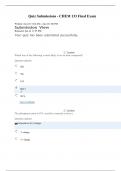Chem133 Study guides, Class notes & Summaries
Looking for the best study guides, study notes and summaries about Chem133? On this page you'll find 147 study documents about Chem133.
Page 3 out of 147 results
Sort by
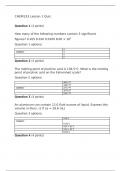
-
CHEM133 Week 2 Lesson 1 Quiz
- Exam (elaborations) • 9 pages • 2023
- Available in package deal
-
- $29.99
- + learn more
1. Question: How many of the following numbers contain 3 significant figures? 2. Question: The melting point of picolinic acid is 136.5°C. What is the melting point of picolinic acid on the Fahrenheit scale? 3. Question: An aluminum can contain 12.0 fluid ounces of liquid. Express this volume in liters. (1 fl oz = 29.6 mL) 4. Question: An aluminum can contain 12.0 fluid ounces of liquid. Express this volume in liters. (1 fl oz = 29.6 mL) 5. Question: In 1828, the diameter of the U.S. dime w...
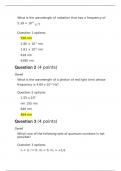
-
CHEM133 Week 6 Lesson 3 Quiz
- Exam (elaborations) • 16 pages • 2023
- Available in package deal
-
- $34.79
- + learn more
1. Question: What is the wavelength of radiation that has a frequency of 5.39 × 1014 s–1? 2. Question: What is the wavelength of a photon of red light (nm) whose frequency is 4.64 x 1014 Hz? 3. Question: Which one of the following sets of quantum numbers is not possible? 4. Question: In Bohr's atomic theory, when an electron moves from one energy level to another energy level more distant from the nucleus: 5. Question: Calculate the wavelength of a neutron that has a velocity of 250 cm/s...
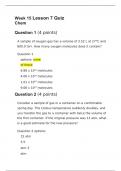
-
CHEM133 Week 15 Lesson 7 Quiz (All Correct)
- Exam (elaborations) • 19 pages • 2023
- Available in package deal
-
- $25.48
- + learn more
1. Question: A sample of oxygen gas has a volume of 3.52 L at 27°C and 800.0 torr. How many oxygen molecules does it contain? 2. Question: Consider a sample of gas in a container on a comfortable spring day. The Celsius temperature suddenly doubles, and you transfer the gas to a container with twice the volume of the first container. If the original pressure was 12 atm, what is a good estimate for the new pressure? 3. Question: Gas A and gas B are combined in a flask at initial pressures of 1...
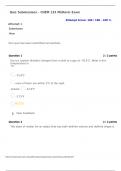
-
CHEM133 Week 7 Midterm Exam (Spring)
- Exam (elaborations) • 26 pages • 2023
-
- $21.49
- + learn more
1. Question: Dry ice (carbon dioxide) changes from a solid to a gas at –78.5°C. What is this temperature in °F? 2. Question: The state of matter for an object that has both definite volume and definite shape is 3. Question: In 1828, the diameter of the U.S. dime was changed to approximately 18 mm. What is this diameter when expressed in nanometers? 4. Question: A piece of antimony with a mass of 17.41 g is submerged in 46.3 cm3 of water in a graduated cylinder. The water level increases t...
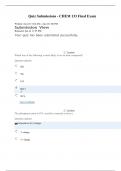
-
CHEM133 Week 16 Final Exam (Spring)
- Exam (elaborations) • 19 pages • 2023
- Available in package deal
-
- $39.99
- + learn more
1. Question: Calculate the lattice energy of NaBr(s), given the following thermochemical equations, where ΔIE and ΔEA are ionization energy and electron affinity, respectively. 2. Question: In which case is the bond polarity incorrect? 3. Question: The phosphorus atom in PCl3 would be expected to have a 4. Question: Which of the following bonds would be the most polar without being considered ionic? 5. Question: Calculate the standard enthalpy of formation (ΔHformation) for LiCl(s) given ...
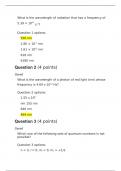
-
CHEM133 Week 6 Lesson 3 Quiz (All Correct)
- Exam (elaborations) • 16 pages • 2023
- Available in package deal
-
- $30.48
- + learn more
1. Question: What is the wavelength of radiation that has a frequency of 5.39 × 1014 s–1? 2. Question: What is the wavelength of a photon of red light (nm) whose frequency is 4.64 x 1014 Hz? 3. Question: Which one of the following sets of quantum numbers is not possible? 4. Question: In Bohr's atomic theory, when an electron moves from one energy level to another energy level more distant from the nucleus: 5. Question: Calculate the wavelength of a neutron that has a velocity of 250 cm/s...
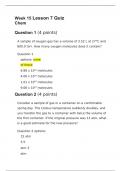
-
CHEM133 Week 15 Lesson 7 Quiz
- Exam (elaborations) • 19 pages • 2023
-
- $21.49
- + learn more
1. Question: A sample of oxygen gas has a volume of 3.52 L at 27°C and 800.0 torr. How many oxygen molecules does it contain? 2. Question: Consider a sample of gas in a container on a comfortable spring day. The Celsius temperature suddenly doubles, and you transfer the gas to a container with twice the volume of the first container. If the original pressure was 12 atm, what is a good estimate for the new pressure? 3. Question: Gas A and gas B are combined in a flask at initial pressures of 1...
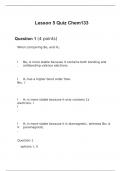
-
CHEM133 Week 11 Lesson 5 Quiz (All Correct)
- Exam (elaborations) • 17 pages • 2023
- Available in package deal
-
- $25.48
- + learn more
1. Question: When comparing Be2 and H2: 2. Question: Atoms that are sp2 hybridized form ____ pi bond(s). 3. Question: The hybridization of the nitrogen atom in the cation NH2+ is: 4. Question: Which one of the following molecules has an atom with an incomplete octet? 5. Question: Nitrous oxide (N2O) is sometimes called "laughing gas". What is the formal charge on the central nitrogen atom in the most favorable Lewis structure for nitrous oxide based on minimizing formal charge overall? 6. Q...
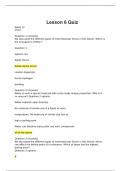
-
CHEM133 Week 13 Lesson 6 Quiz
- Exam (elaborations) • 13 pages • 2023
- Available in package deal
-
- $32.18
- + learn more
1. Question: We discussed the different types of intermolecular forces in this lesson. Which is the strongest in CF2H2 ? 2. Question: Water is such a special molecule with some really unique properties. Why is it so unusual? 3. Question: We discussed the different types of intermolecular forces in this lesson, which can affect the boiling point of a substance. Which of these has the highest boiling point? 4. Question: If you have 2.00 x 103 J of energy, what mass (g) of solid butane (C4H10O) ...

How much did you already spend on Stuvia? Imagine there are plenty more of you out there paying for study notes, but this time YOU are the seller. Ka-ching! Discover all about earning on Stuvia

